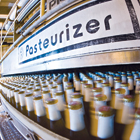
Many Miller products are heat-pasteurized, while few Coors products are-one of the adjustments that MillerCoors has had to make at its Milwaukee brewery (among others). (Photo by Vito Palmisano)
Some of these, like thermochromatic ink on Coors Light bottles and cans, are highly visible to consumers. Others aren’t, but are no less important. The flagship MillerCoors plant, part of the company’s U.S. headquarters in Milwaukee, is coping with those changes beautifully.
One of the biggest changes has been, simply, the merger between Miller and Coors. As David Klante, vice president for engineering and packaging, put it, the two companies had to learn “to make each other’s beers.”
In operational terms, one big difference is that several of Miller’s beers are heat-pasteurized, while almost none of Coors’ are. This has required some parallel operations in the MillerCoors’ eight facilities, including Milwaukee. Bottling unpasteurized beer requires an extra-clean environment, with filtered air and limited operator access, to minimize microorganisms. Unpasteurized products, including Miller Genuine Draft, Coors and Coors Light, are bottled in a cleanroom in the Milwaukee facility. (In other plants, MillerCoors has installed a kind of shroud that provides extra protection from microorganisms while taking up less space than a cleanroom.)
Over the years, MillerCoors has consolidated the packaging lines at brew house No. 3 in Milwaukee from 11 down to three: two for bottles and one for cans. The bottle filling is done on two 96-valve volumetric fillers fromKHS USAand can run up to 1,400 containers per minute each. The heat-pasteurized products, like Miller Lite and Miller High Life, go through a pasteurizer from the H&K div. of KHS that heats the beer to about 140° F. and cools it back down to room temperature in the course of a 50-minute cycle. A printer fromVideojet Technologiesadds date and lot codes, and a quality-control system fromIndustrial Dynamics/filtecchecks for missing crowns.
There’s another important aspect of the Milwaukee operations that requires combining two techniques: case-packing. The two techniques in question are reshipping and bulk glass depalletizing.
Re-shipping involves receiving empty bottles inside paperboard carriers nested inside the shipping cases. The bottles are extracted, filled, otherwise processed and then replaced inside the carriers in the cases. This procedure, common among American brewers, is used for the six-packs that make up the bulk of MillerCoors’ bottles.
But for 12- and 18-pack paperboard carriers, Milwaukee uses the “reshipper” method common among brewers in Europe and elsewhere. Bottles arrive in bulk form, on slipsheets, and the carriers come as flats, erected by machinery from the Riverwood div. ofGraphic Packaging Int’l. Combining these two methods requires an intelligent material-handling system that can route bottles from one kind of case packer to another, as needed.
-Pan Demetrakakes, editor
To access our other 2010 Plants of the Year,click here.
